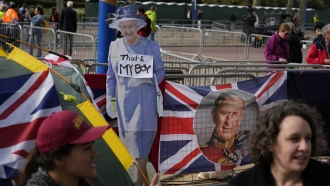“Prince William’s First Public Statement: Updates on the Health of His Wife and Parents”
Thursday marked Prince William’s initial return to royal engagements following significant health challenges faced by his father, King Charles III, and his wife, Kate Middleton. At a charity gala dinner, the 41-year-old future king expressed gratitude for the outpouring of support from the public in response to his family’s health issues, which he addressed publicly for the first time. Earlier in the day, he had overseen an investiture ceremony at Windsor Castle.
Reflecting on the recent medical focus in his life, Prince William injected a touch of humor into his speech, jesting that he chose to attend an air ambulance function as a means of “escaping it all.”
The event, attended by the queen, a former air ambulance pilot herself, provided an opportunity for her to engage with fellow pilots and interact with celebrities, including Tom Cruise.
Meanwhile, King Charles III continues his outpatient treatment for an undisclosed malignancy, underscoring the ongoing challenges faced by the royal family amidst health concerns.

The coronation of King Charles III holds significant importance as it marks the formal ascension of the monarch to the throne and signifies the continuation of the royal lineage. It is a ceremonial event steeped in tradition and symbolism, signifying the monarch’s role as the head of state and the embodiment of national unity and continuity.
In the context of the current situation, with King Charles III undergoing treatment for cancer and temporarily withdrawing from public appearances, the timing of his coronation becomes particularly significant. The coronation would serve as a moment of national unity and stability, reaffirming the monarchy’s continuity and providing a sense of reassurance to the public during a challenging time for the royal family.
Despite the challenges posed by King Charles III’s illness, the anticipation of his coronation remains a symbol of hope and continuity for the House of Windsor and the United Kingdom as a whole.

The coronation of King Charles III holds symbolic and ceremonial value, serving as a pivotal moment in affirming the continuity and stability of the monarchy. However, amidst the recent health challenges faced by key members of the royal family, including the king himself, the event has prompted renewed scrutiny on the cost of the monarchy.
King Charles III, who pledged to reduce the expenses of the monarchy, faces increased challenges in maintaining this commitment, particularly with prominent members of the family, such as his wife, Kate Middleton, and his son, Prince Harry, currently unable to fulfill their public duties due to illness or personal reasons.
Beyond the grandeur of royal processions and state visits, the royal family undertakes numerous lesser-known engagements each year to engage with the public, recognize achievements, and support charitable endeavors. These appearances serve to elevate the visibility and credibility of various causes and organizations, contributing to their fundraising efforts.
The recent public appearance of King Charles III, following his cancer diagnosis, coincided with a brief reunion with his son, Prince Harry, who traveled from California to be by his father’s side. This meeting has sparked hopes for reconciliation between the father and son, whose relationship has been strained in recent years, exacerbated by Harry’s public criticisms of the royal family and his and Meghan’s decision to step back from royal duties in 2020.
While Harry and Meghan were once seen as key figures in modernizing the monarchy and connecting with younger generations, their withdrawal from royal life has shifted the dynamics within the royal family and raised questions about its future direction and relevance.



